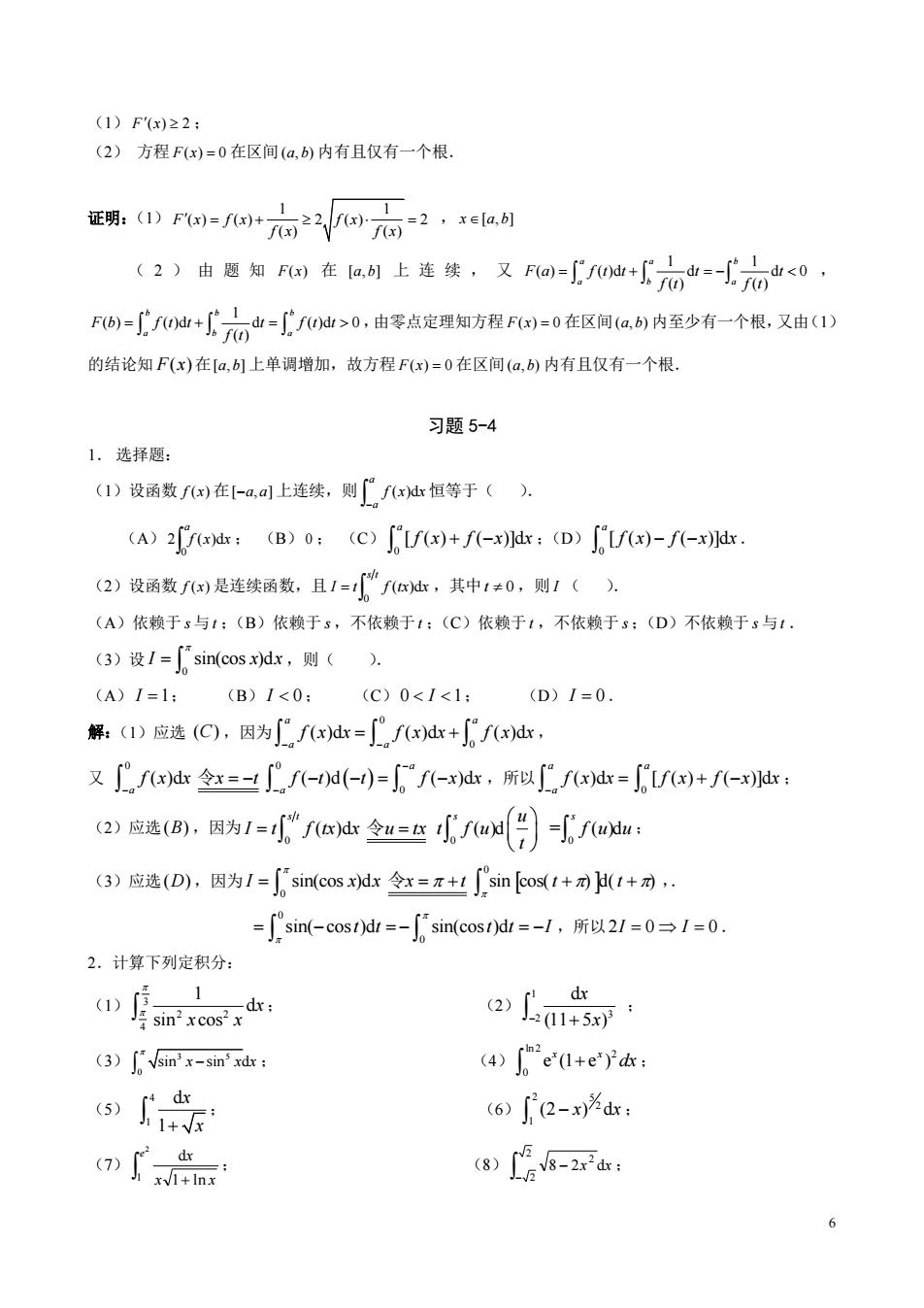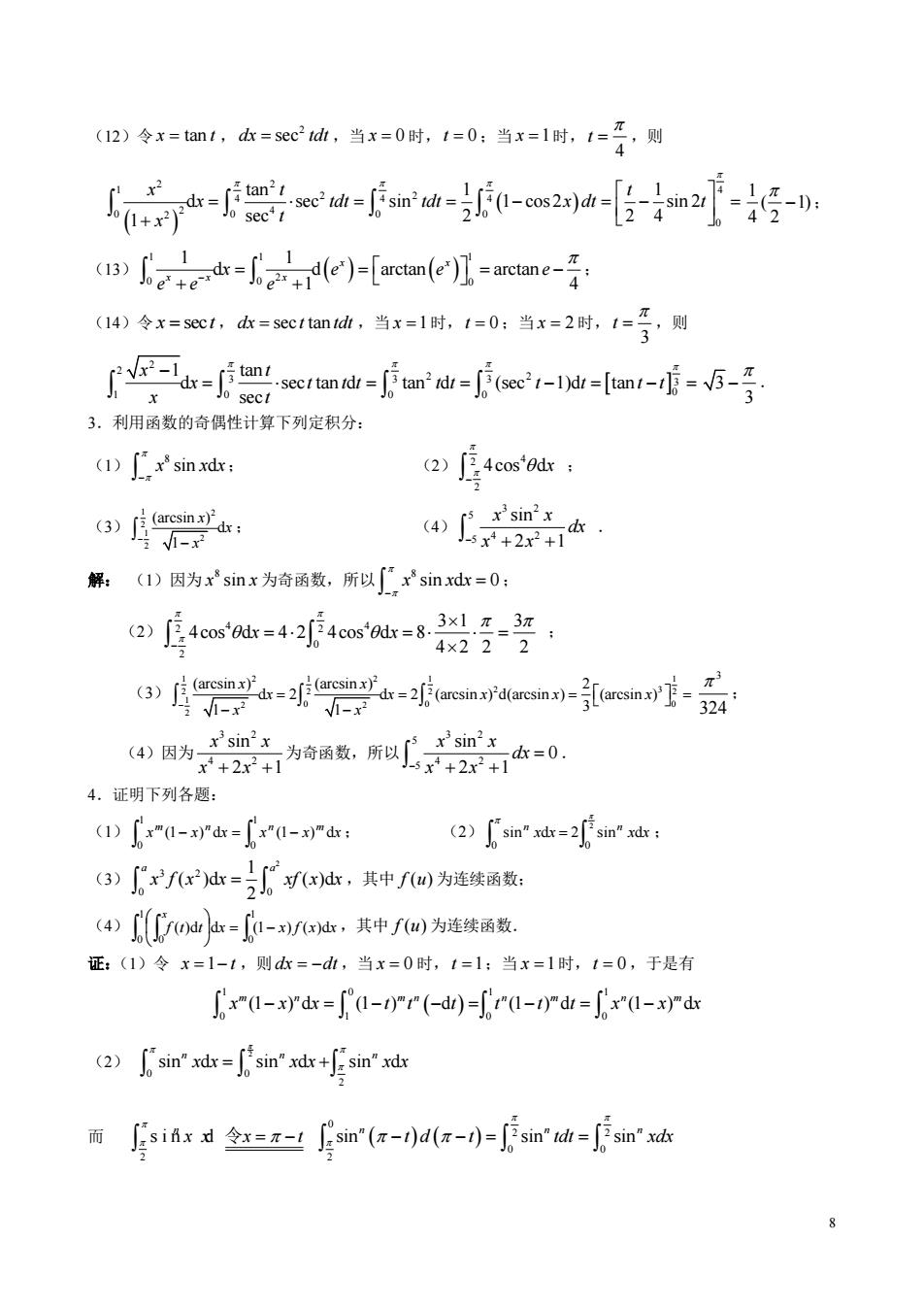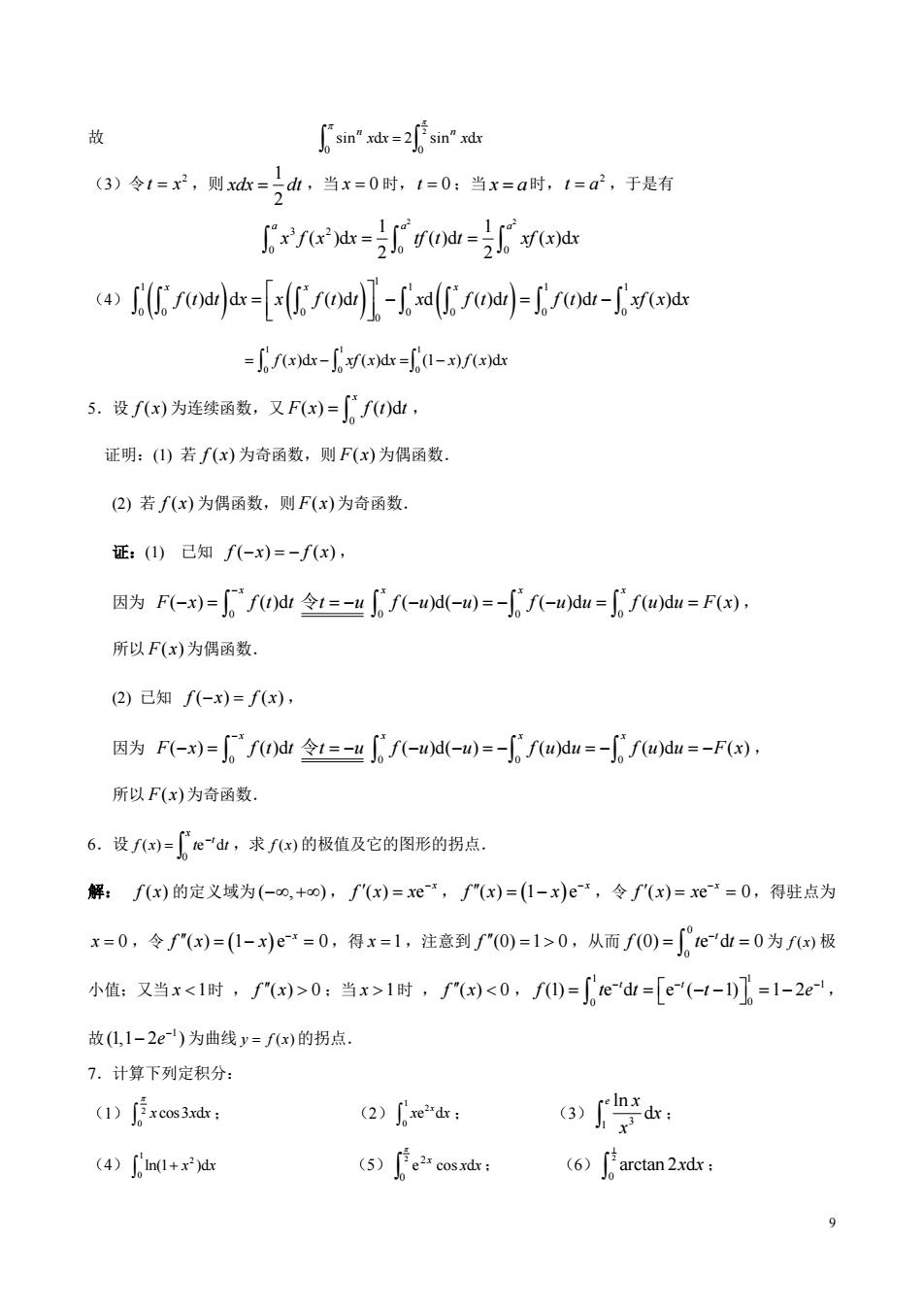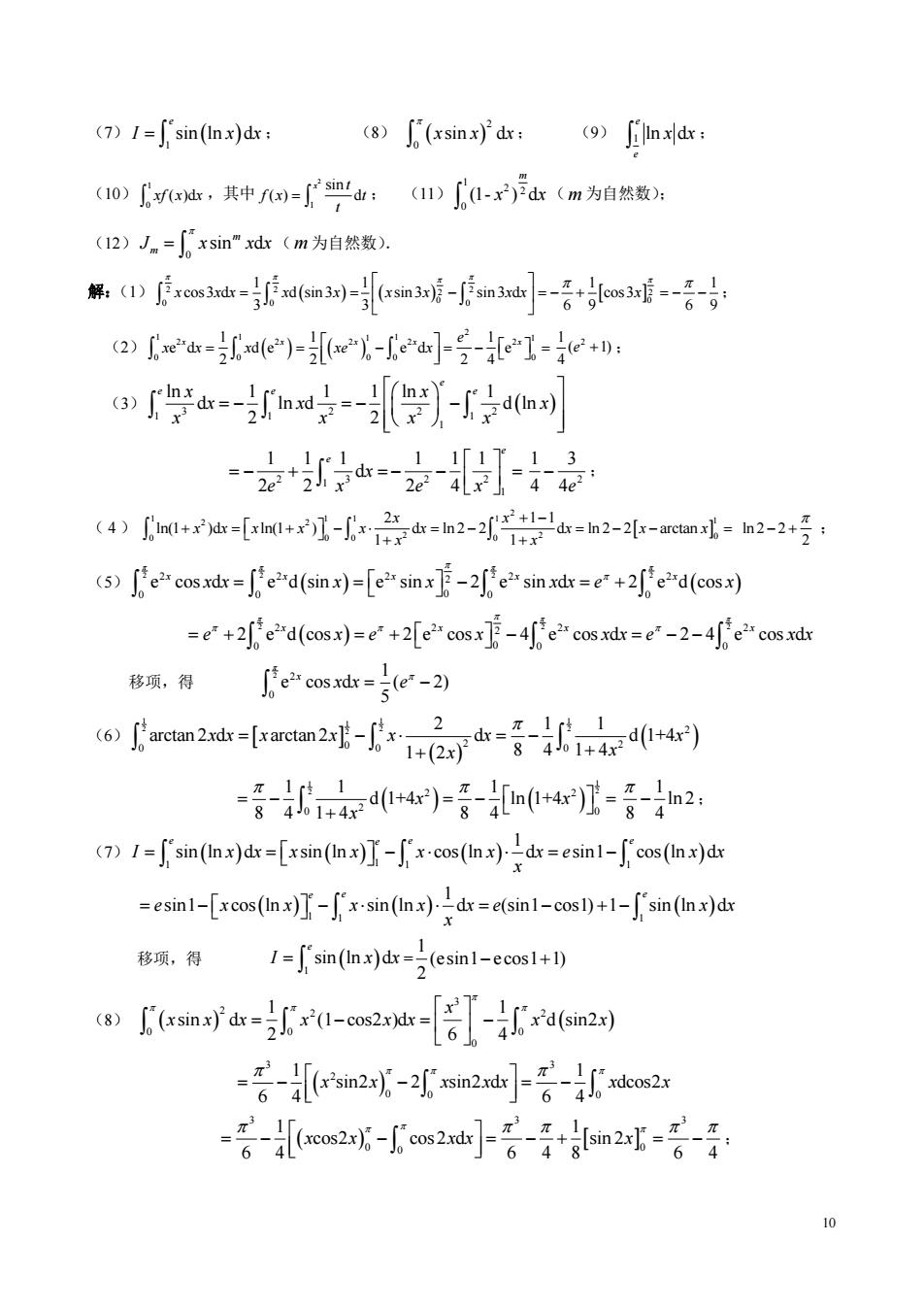
(1)F(x)22: (2)方程F(x)=0在区间(a,b)内有且仅有一个根. 证明:①)F)=+高之22,ea.创 (2)由题知在a1上连续,又F-0t+=-0<0, F0=0a:0-广0d>0,由零点定理知方起F=-0在区间a内至少有一个根,又由(D 的结论知F(x)在[a,b]上单调增加,故方程F(x)=0在区间(a,b)内有且仅有一个根. 习题5-4 1.选择题: (1)设函数fx)在-aa上连续,则,fxd恒等于(), (A)2dx:(B)o:(C)[Lf(x)+f(-x)dx:(D)[Lf(x)-f(-x)ldx (2)设函数f)是连续函数,且1=fx灿,其中1≠0,则1()。 (A)依赖于s与1:(B)依赖于s,不依赖于t:(C)依赖于1,不依赖于s:(D)不依赖于s与t. (3)设I=∫Dsin(cosx)dr,则(). (A)I=1: (B)I<0: (c)0<I<1: (D)1=0. 解:(1)应选(C),因为∫,fx)dr=∫心f(x)dr+心fxd, 又∫fx)d含x=-0f-)d(-)=f-x)dr,所以f)=gfx)+f-xr: 2)应滤(B).因为1=few令=:1u-fot: (3)应选(D),因为I=sin((cos x)dx=元+'sin eos(1+列H(1+列 =”sin(-cos)d=-Jsin(cos0d=-,所以21=0→I=0. 2.计算下列定积分: 1 (1) dx dx: JΞsin2xcos2x 201+5 (3)sin'x-sin'xdx: feae (5)」 (6)(2-x)d: ) dx: xv1+Inx 6
6 (1) F (x) 2 ; (2) 方程 F(x) 0 在区间 (a, b) 内有且仅有一个根. 证明:(1) 1 1 ( ) ( ) 2 ( ) 2 ( ) ( ) F x f x f x f x f x , x [a, b] ( 2 ) 由题知 F x( ) 在 [a, b] 上连续 , 又 1 1 ( ) ( )d d d 0 ( ) ( ) a a b a b a F a f t t t t f t f t , 1 ( ) ( )d d ( )d 0 ( ) b b b a b a F b f t t t f t t f t ,由零点定理知方程 F(x) 0 在区间 (a, b) 内至少有一个根,又由(1) 的结论知 F x( ) 在 [a, b] 上单调增加,故方程 F(x) 0 在区间 (a, b) 内有且仅有一个根. 习题 5-4 1. 选择题: (1)设函数 f x( ) 在 [ , ] a a 上连续,则 a a f (x)dx 恒等于( ). (A) a f x x 0 2 ( )d ; (B) 0 ; (C) 0 [ ( ) ( )]d a f x f x x ;(D) 0 [ ( ) ( )]d a f x f x x . (2)设函数 f (x) 是连续函数,且 s t I t f tx x 0 ( )d ,其中 t 0 ,则 I ( ). (A)依赖于 s 与 t ;(B)依赖于 s ,不依赖于 t ;(C)依赖于 t ,不依赖于 s ;(D)不依赖于 s 与 t . (3)设 0 I x x sin(cos )d ,则( ). (A) I 1 ; (B) I 0 ; (C) 0 1 I ; (D) I 0. 解:(1)应选 ( ) C ,因为 0 0 ( )d ( )d ( )d a a a a f x x f x x f x x , 又 0 0 0 ( )d ( )d ( )d a a a f x x x t f t t f x x 令 ,所以 ( )d a a f x x 0 [ ( ) ( )]d a f x f x x ; (2)应选 ( ) B ,因为 0 0 0 ( )d ( )d = ( )d s t s s u I t f tx x u tx t f u f u u t 令 ; (3)应选 ( ) D ,因为 0 0 I x x x t t t sin(cos )d sin cos( ) d( ) 令 ,. 0 0 sin( cos )d sin(cos )d t t t t I ,所以 2 0 0 I I . 2.计算下列定积分: (1) 3 2 2 4 1 d sin cos x x x ; (2) 1 3 2 d (11 5 ) x x ; (3) 3 5 0 sin sin d x x x ; (4) ln 2 2 0 e (1 e ) x x dx ; (5) 4 1 d 1 x x ; (6) 2 5 2 1 (2 ) d x x ; (7) 2 1 1 ln e d x x x ; (8) 2 2 2 8 2x dx ;

o2 (0)cos.cos2xdr: alDJ,V-ear. (12) x _dx 0(1+x2 (14) -1dx 3 emoa1soa0+50-ou4syr1-0 (3)isinsinin xcosin co -wucw-wtwc- we0+e旷=a+errdte)-o+eyT-9 x4-=2可旷-0*0=2-+pf-2-子 o2-as=-fe-ae--3-灯-月 nf0-hjia0h=2r可-26- (8)J68-2rdx=28-2rdk全x=2snl=28-8sm7d2sin)=8wW万csd -+ow2=a+os2a0e-[径+m2n月]-x+2: o42+-m+l-号 oowos2ad=gowxa2t-far+ot-传x+m- 令=e=1,-=,当x=0时,1=0:当x-h2时,1=5 ,则 e--jt-92- 1
7 (9) 0 2 2 2 2 d x x x ; (10) 2 2 cos cos 2 d x x x ; (11) ln 2 2 0 1 e dx x ; (12) 2 1 2 0 2 d 1 x x x ; (13) 1 0 1 d x x x e e ; (14) 2 2 1 1 d x x x . 解:(1) 3 3 3 2 3 2 2 2 4 4 4 4 1 1 2 3 d 4 d 2 csc 2 d 2 2 cot 2 sin cos sin 2 3 x x x x x x x x ; (2) 1 1 1 3 2 3 2 2 2 d 1 1 51 (11 5 ) d 11 5 (11 5 ) (11 5 ) 5 10 512 x x x x x ; (3) 3 3 3 5 3 2 2 2 0 0 0 2 sin sin d sin cos d sin cos d sin cos d x x x x x x x x x x x x 3 3 5 5 2 2 2 2 2 2 0 2 0 2 2 2 4 sin d sin sin d sin sin sin 5 5 5 x x x x x x ; (4) ln 2 ln 2 ln 2 2 2 3 0 0 0 1 19 e (1 e ) (1 e ) 1+e (1 e ) 3 3 x x x x x dx d ; (5) 4 1 d 1 x x 2 令x t 2 2 2 2 2 1 1 1 1 1 2 d 1 1 1 3 2 d 2 d 1 2 ln(1 ) 2 ln 1 1 1 2 t t t t dt t t t t t ; (6) 2 2 2 5 5 7 2 2 2 1 1 1 2 2 (2 ) d (2 ) d 2 (2 ) 7 7 x x x x x ; (7) 2 2 1 2 2 1 1 1 d 1 ln d 1 ln 2 1 ln 2 3 1 1 ln e e x e x x x x x ; (8) 2 2 2 2 2 0 8 2 d 2 8 2 d x x x x 令x t 2sin 4 2 0 2 8 8sin d 2sin t t 4 2 0 8 2 cos tdt 4 4 4 4 0 0 0 0 1 1 2 1 cos 2 4 2 cos 2 2 4 2 sin 2 2 2 2 4 2 t dt dt td t t ; (9) 0 0 0 2 2 2 2 2 d 1 d 1 arctan( 1) 2 2 2 1 1 x x x x x x ; (10) 2 2 2 2 2 0 0 0 1 2 cos cos 2 d 2 cos cos 2 d cos3 cos d sin 3 sin 3 3 x x x x x x x x x x x ; (11)令 2 1 e x t , 1 2 ln(1 ) 2 x t , 2 1 t dx dt t ,当 x 0 时, t 0 ;当 x ln 2 时, 3 2 t ,则 3 3 ln 2 2 2 2 2 2 0 0 0 1 1 e d d 1 d 1 1 x t x t t t t t 3 2 0 1 1 ln 2 1 t t t 3 ln(2 3) 2 ;

(12)令x=tant,d=sec2tdl,当x=0时,t=0:当x=1时,t= ,则 可--a-0w2a-6f-行- ()[arctan(e)aretane (14)令x=sec1,k=sec1tan1d,当x=1时,1=0:当x=2时,1=T,则 3 -黑xem--e-t-a--5-号 3.利用函数的奇偶性计算下列定积分: (1)sinxdx: (2)4cosdx 8月 (4) sin'x d J-5x4+2x2+1 解: (1)因为sinx为奇函数,所以xsinxdx=0: 2)且4cos0ur=4-2后4eos0ux=83x1g=3n 4×222 √-x2 (4)因为+2x+1 为sinx为奇函数,所以加xdk=0. 4.证明下列各题: (1)a-x)=x1-x: 2)sm”d=2snd: (3)c=x达,英中/a为连续属数: (4)0a山--et,其中a0为连续函数。 证:(1)令x=1-1,则dr=-d1,当x=0时,1=1;当x=1时,t=0,于是有 Sx"(-xdx="(-t)"r(-dr)=fr"Q-t)"dr=fx"(-x)"dx (2)sin"d sin"sin" 而了 six过氢=4snra-小dr-小-月smi=原m'h
8 (12)令 x t tan , 2 dx tdt sec ,当 x 0 时, t 0 ;当 x 1 时, 4 t ,则 2 2 1 4 4 4 4 2 2 2 4 0 0 0 0 2 0 tan 1 1 d sec sin 1 cos 2 sin 2 sec 2 2 4 1 x t t x tdt tdt x dt t t x 1 ( 1) 4 2 ; (13) 1 1 1 2 0 0 0 1 1 d d arctan arctan 1 4 x x x x x x e e e e e e ; (14)令 x t sec , dx t tdt sec tan ,当 x 1 时, t 0 ;当 x 2 时, 3 t ,则 2 2 3 3 3 2 2 3 0 1 0 0 0 1 tan d sec tan d tan d (sec 1)d tan sec x t x t t t t t t t t t x t 3 3 . 3.利用函数的奇偶性计算下列定积分: (1) 8 x x x sin d ; (2) 2 4 2 4cos dx ; (3) 1 2 2 1 2 2 (arcsin ) d 1 x x x ; (4) 3 2 5 4 2 5 sin 2 1 x x dx x x . 解: (1)因为 8 x x sin 为奇函数,所以 8 x x x sin d 0 ; (2) 2 2 4 4 0 2 3 1 3 4cos d 4 2 4cos d 8 4 2 2 2 x x ; (3) 1 2 2 1 1 1 2 2 3 2 2 2 1 2 2 0 0 0 2 (arcsin ) (arcsin ) 2 d 2 d 2 (arcsin ) d(arcsin ) (arcsin ) 1 1 3 x x x x x x x x x 3 324 ; (4)因为 3 2 4 2 sin 2 1 x x x x 为奇函数,所以 3 2 5 4 2 5 sin 0 2 1 x x dx x x . 4.证明下列各题: (1) 1 0 1 0 x (1 x) dx x (1 x) dx m n n m ; (2) 2 0 0 sin d 2 sin d x x x x n n ; (3) 2 3 2 0 0 1 ( )d ( )d 2 a a x f x x xf x x ,其中 f u( ) 为连续函数; (4) 1 0 1 0 0 f (t)dt dx (1 x) f (x)dx x ,其中 f u( ) 为连续函数. 证:(1)令 x t 1 ,则 dx dt ,当 x 0 时, t 1 ;当 x 1 时, t 0 ,于是有 1 0 1 1 0 1 0 0 (1 ) d (1 ) d (1 ) d (1 ) d m n m n n m n m x x x t t t t t t x x x (2) 2 0 0 2 sin d sin d sin d n n n x x x x x x 而 2 sin d n x x 令x t 0 2 2 0 0 2 sin sin sin n n n t d t tdt xdx

故 sin”t=2sin”xd (3》1=,则达=,当x=0时1=0:当x=a时,1=0,于是有 xfet=oa-t r)xrr)- -f(x)dx-()dx=(1-x)f(x)dx 5.设fx)为连续函数,又F(y)=), 证明:(1)若f(x)为奇函数,则F(x)为偶函数. (2)若f(x)为偶函数,则F(x)为奇函数。 证:(1)已知f(-x)=-f(x), 因为F(-x)=f)令1=-uf(-wWd(-0=-f-u0)du=fw)du=F(x), 所以F(x)为偶函数. (2)己知f(-x)=f(x), 因为F(-x)='f0)d令1=-wjf-wd(-w=-f0)du=-0fudu=-Fx, 所以F(x)为奇函数. 6.设fx)=广ed,求f)的极值及它的图形的拐点. 解:f(x)的定义域为(-o,+o),f"(x)=xe,∫"(x)=((1-x)e,令f'(x)=xe-0,得驻点为 x=0,令f"(x)=((1-)e=0,得x=1,注意到∫"0)=1>0,从而f0)=e'd=0为f极 小值:又当x<1时,f"(x)>0:当x>1时,∫"(x)<0,f0=∫e'd=[e(-1-1)]=1-2e, 故(1,1-2e)为曲线y=f(x)的拐点. 7.计算下列定积分: (1)[xcos3xdx: (2): (4)0in1+x2)d (5) (6)arctan2xd: 9
9 故 2 0 0 sin d 2 sin d x x x x n n (3)令 2 t x ,则 1 2 xdx dt ,当 x 0 时, t 0 ;当 x a 时, 2 t a ,于是有 2 2 3 2 0 0 0 1 1 ( )d ( )d ( )d 2 2 a a a x f x x tf t t xf x x (4) 1 1 1 1 1 0 0 0 0 0 0 0 0 ( )d d ( )d d ( )d ( )d ( )d x x x f t t x x f t t x f t t f t t xf x x 1 1 1 0 0 0 f x x xf x x x f x x ( )d ( )d (1 ) ( )d 5.设 f x( ) 为连续函数,又 0 ( ) ( )d x F x f t t , 证明:(1) 若 f x( ) 为奇函数,则 F x( ) 为偶函数. (2) 若 f x( ) 为偶函数,则 F x( ) 为奇函数. 证:(1) 已知 f x f x ( ) ( ) , 因为 0 0 0 0 ( ) ( )d ( )d( ) ( )d ( )d ( ) x x x x F x f t t t u f u u f u u f u u F x 令 , 所以 F x( ) 为偶函数. (2) 已知 f x f x ( ) ( ) , 因为 0 0 0 0 ( ) ( )d ( )d( ) ( )d ( )d ( ) x x x x F x f t t t u f u u f u u f u u F x 令 , 所以 F x( ) 为奇函数. 6.设 f x t t x t ( ) e d 0 ,求 f x( ) 的极值及它的图形的拐点. 解: f x( ) 的定义域为 ( , ) , ( ) e x f x x , ( ) 1 e x f x x ,令 ( ) e 0 x f x x ,得驻点为 x 0 ,令 ( ) 1 e 0 x f x x ,得 x 1 ,注意到 f (0) 1 0 ,从而 0 0 (0) e d 0 t f t t 为 f x( ) 极 小值;又当 x 1 时 , f x ( ) 0 ;当 x 1 时 , f x ( ) 0 , 1 1 1 0 0 (1) e d e ( 1) 1 2 t t f t t t e , 故 1 (1,1 2 ) e 为曲线 y f x ( ) 的拐点. 7.计算下列定积分: (1) 2 0 x x x cos3 d ; (2) 1 2 0 e dx x x ; (3) 3 1 ln d e x x x ; (4) 1 2 0 ln(1 )d x x (5) 2 0 2 e cos d x x x ; (6) 1 2 0 arctan 2 dx x ;

(7)1=∫sin(nx)dr: (8)∫(xsinx')dr: (9)x: (10)c地,其中f=广g:()0-x)d(m为自然数: (12)Jm=xsin"xdr(m为自然数). 解.月own=写月d6 (in3)n3听-ma名+as明-君 2)e-ae)e2-小ea]-e--e+: o=-n对时-g 立+咖品这 (4)n0+fw-[n0+r--n2-2s=h2-2g-mm或=h2-2+经: (5)cos=d(sin)sinxsind(cos.) -e+2fed(cosx)=e+2[ecosx-cos.xdx-e"-2-4fcos.xdr 移项,得 co2) ooat-m2或-产e-香he) -g-r0*)营-n-君-2 (7in(In.)dx-xsin(n.)xc(n)desin1-cos(.)dx -esin1-[xcos(Inxsin(in x).dx=e(sin1-cos1)+1-['sin(Inx)dx 移项,得 1sin(In )d(esinl-ccos1+) ⑧)(esn时旷srl-eo2xt-[g-Hrd6sm2d =看-0en2-2sn2个]石-ds2r -若-lam2或-os2]-君-子+tm2-号-异 0
10 (7) 1 sin ln d e I x x ; (8) 2 0 x x x sin d ; (9) 1 ln d e e x x ; (10) 1 0 xf x x ( )d ,其中 2 1 sin ( ) d x t f x t t ; (11) 1 2 2 0 (1- ) d m x x ( m 为自然数); (12) 0 sin d m m J x x x ( m 为自然数). 解:(1) 2 2 2 2 2 0 0 0 0 0 1 1 1 1 cos3 d d sin 3 sin 3 sin 3 d cos3 3 3 6 9 6 9 x x x x x x x x x x ; (2) 2 1 1 1 1 1 2 2 2 2 2 0 0 0 0 0 1 1 1 e d d e e d e 2 2 2 4 x x x x x e x x x xe x 1 2 ( 1) 4 e ; (3) 3 2 2 2 1 1 1 1 ln 1 1 1 ln 1 d ln d d ln 2 2 e e e e x x x x x x x x x 2 3 2 2 1 1 1 1 1 1 1 1 d 2 2 2 4 e e x e x e x 2 1 3 4 4e ; ( 4 ) 2 1 1 1 1 1 2 2 0 2 2 0 0 0 0 2 1 1 ln(1 )d ln(1 ) d ln 2 2 d ln 2 2 arctan 1 1 x x x x x x x x x x x x x ln 2 2 2 ; (5) 2 2 2 2 2 2 2 2 2 2 0 0 0 0 0 e cos d e d sin e sin 2 e sin d 2 e d cos x x x x x x x x x x x e x 2 2 2 2 2 2 2 2 0 0 0 0 2 e d cos 2 e cos 4 e cos d 2 4 e cos d x x x x e x e x x x e x x 移项,得 2 2 0 e cos d x x x 1 ( 2) 5 e (6) 1 1 1 1 2 2 2 2 2 0 2 2 0 0 0 2 1 1 arctan 2 d arctan 2 d d 1+4 1 2 8 4 1 4 x x x x x x x x x 1 1 2 2 2 2 2 0 0 1 1 1 d 1+4 ln 1+4 8 4 1 4 8 4 x x x 1 ln 2 8 4 ; (7) 1 1 1 1 1 sin ln d sin ln cos ln d sin1 cos ln d e e e e I x x x x x x x e x x x 1 1 1 1 sin1 cos ln sin ln d (sin1 cos1) 1 sin ln d e e e e x x x x x e x x x 移项,得 1 sin ln d e I x x = 1 (esin1 ecos1 1) 2 (8) 3 2 2 2 0 0 0 0 1 1 sin d (1 cos2 )d d sin2 2 6 4 x x x x x x x x x 3 3 2 0 0 0 1 1 sin2 2 sin2 d dcos2 6 4 6 4 x x x x x x x 3 3 3 0 0 0 1 1 cos2 cos 2 d sin 2 6 4 6 4 8 6 4 x x x x x ;